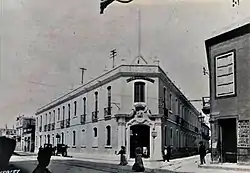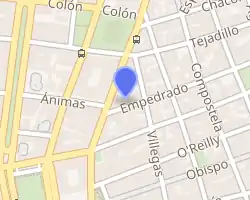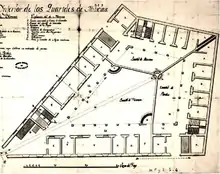Cuartel de Milicias, Havana
The Cuartel de Milicias was the largest barracks in the city of Havana in the 18th century. Conceived as the headquarters of the militia battalions that at that time were classified according to their member's skin color, white, or brown.
| Cuartel de Milicias | |
|---|---|
 | |
 | |
| General information | |
| Type | Military |
| Address | Monserrate and Empedrado |
| Town or city | Havana |
| Country | Cuba |
| Coordinates | 23.139564°N 82.356708°W |
| Opened | 1787 |
| Technical details | |
| Structural system | Load bearing |
| Material | Masonry |
| Floor count | 3 |
| Design and construction | |
| Architect | Antonio Fernández de Trebejos y Zaldívar |
History
Eventually, the white and brown militias were transferred to Guanabacoa and the building acquired the nickname "Cuartel de Morenos" (dark). It had this function until 1844 and from this year it was assigned to other military dependencies. Its plan is trapezoidal, adapted to the shape of the land determined by the layout of the streets. Although it has been transformed, in general, it still retains its two maximum values: the central courtyard enclosure with a perimeter portico on both floors.
Architecture

Its plan is trapezoidal, adapted to the shape of the land in Old Havana determined by the layout of Calles Monserrate and Empedrado. It was built by the architect Antonio Fernández de Trebejos y Zaldívar who was the architect of Palacio de los Capitanes Generales[lower-alpha 1]. Although it has been transformed, it still conserves its two maximum values: the central courtyard enclosure with a perimeter arcade on both floors, and the main doorway with its mixtilinear garrison, located on the chamfered corner and attributed to Pedro de Medina.[2]
Notes
- Antonio Fernández de Trebejos y Zaldívar. 18th-century architect, colonel of engineers in the Spanish army, author of some of the most notable Havana buildings of the colonial era.[1]
References
- "Antonio Fernández de Trebejos y Zaldívar". Retrieved 2022-03-06.
- "Cuartel de Milicias (La Habana)". Retrieved 2022-03-05.
| Wikimedia Commons has media related to Cuartel de Milicias, Havana. |
| Wikisource has the text of the 1911 Encyclopædia Britannica article "Havana". |